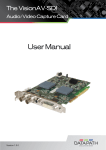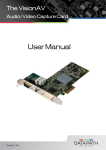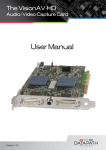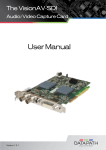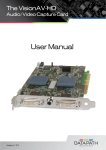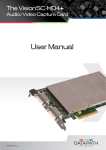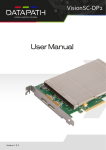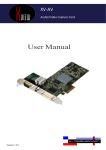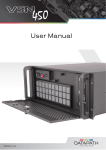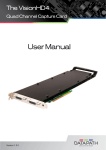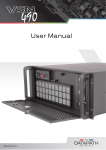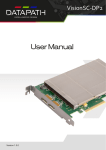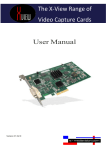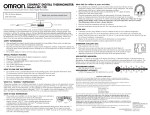Download User Manual - Stemmer Imaging
Transcript
VisionAV User Manual Version 2.0.1 Contents Introduction........................................................................................................................1 Hardware Overview.............................................................................................................2 Flexible Audio Capture.........................................................................................................2 Datapath Unified Vision Driver.............................................................................................2 Models................................................................................................................................2 Specification.......................................................................................................................3 Unpacking...........................................................................................................................4 Installing the Capture Card..................................................................................................5 Installing Multiple Cards......................................................................................................8 Software Installation...........................................................................................................9 Software Overview............................................................................................................10 Video Streaming................................................................................................................10 Vision Software Capabilities..............................................................................................10 Multistream......................................................................................................................11 Vision Application Overview..............................................................................................11 Using the card with other Datapath products....................................................................12 Datapath Limited..............................................................................................................13 Index.................................................................................................................................14 Introduction The VisionAV has two independent video capture channels – one supporting HD capture and a second simultaneously decoding Standard Definition composite video. The VisionAV also adds analog and HDMI audio capture, which can be perfectly synchronised with either video capture channel. • A single card solution for distance learning, lecture capture and web casting • Viewing analog or DVI sources from a wide range of PCs, MACs, Industrial/Medical equipment, cameras and other video equipment. • Videoconferencing DirectShow drivers for WDM Streaming driver supports the following applications to encode, record and stream video over networks or the Internet: • Windows Media Encoder® • VLC • StreamPix • VirtualDub • Adobe Flash Encoder • AMCap • Any other DirectShow encoding software 1 Hardware Overview Dual Channel Video • Channel 1: Digital or Analog HD Video • Channel 2: Composite Video Flexible Audio Capture • Balanced (XLR) and Unbalanced (RCA) from optional module • HDMI audio through HD Video Channel Datapath Unified Vision Driver • Multiple cards per system, 16 streams per channel • Frame sync and time stamping • Direct Show interface • Datapath RGBEasy API Models VisionAV/F VisionAV/H VisionAV/B 2 Specification Board Format PCI-Express x4 low profile card, 68.9mm x 167.6mm Connectors (main board) DVI-I , RCA (female) Connectors (audio board) HD15 (male) for connection of supplied Audio Breakout cable: HDMI Capture • Stereo line in (2 x RCA), stereo balanced in (2 x XLR), stereo line out (2 x RCA) • • 16-way header for connection to main board Supports HDMI 1.3 to 225MHz (including deep colour modes). For HDCP support, contact the Sales Dept at Datapath for more information • HDMI audio can be selected as source for audio streaming. DVI Capture • Incorporates TMDS equalizer to support up to 20m cables. Supports DVI 1.0 RGB 24bit capture to 165MHz. VGA / YPbPr Capture Incorporates TMDS equalizer to support up to 20m cables. Triple ADCs sampling up to 170Msps. Full 4:4:4 sampling, 8 bits per colour. 5-wire, 4-wire or sync-on-green signal formats. Composite Video Capture CCIR601 sampling. PAL, NTSC, SECAM formats automatically detected Audio Capture Stereo Line-In/Stereo balanced inputs with programmable gain (+/-12dB) 16/24 bit sampling at 44.1kHz. Video Capture Memory Video Processing Analog stereo line-out at up to 64kHz sampling, sourced from Analog input or HDMI stream 256MB high bandwidth frame buffer supports triple buffering of HD and SD video. Local storage of complex scatter-gather tables for DMA engine (eliminates read overhead) Polyphase FIR scaling engine (7x5) for hardware downscaling and upscaling Colour space conversion allows captured data to be transferred in any format: DMA Engine • RGB16 bit (5-5-5, 5-6-5), 24 bit (8-8-8) or 32 bit (8-8-8-alpha) • YUV16 bit (4:2:2) • Mono: 8bit Direct DMA to physical or virtual memory buffers with full scatter-gather support. DMA bandwidth : up to 800MB/s 16 independent DMA streams: • Operating System Support Any mix of HD and SD sources, colour space, cropping and scaling parameters Windows XP, Windows Server 2003, Windows Vista, Windows Server 2008, Windows Server 2012, Windows 7, Windows 8 and Linux support (not audio) See www.datapath.co.uk for updates. 3 Power Requirements Max current at 12V – 0.5A Max current at 3.3V – 0.2A Operating Temperature Storage Temperature Relative Humidity Warranty Thermal dissipation – 6.5W 0 to 35 ºC ( 32 to 96ºF) -20 to 70 ºC ( -4 to 158ºF) 5% to 90% non-condensing 3 years We are continuously developing the technology used within our product ranges delivering outstanding innovative solutions, therefore the specification may change from time to time. Unpacking Your packing box should contain the following items: VisionAV/H √ VisionAV/B √ √ X 1 x Full height bracket VisionAV/F √ √ Fitted to base card √ Fitted to base card X √ Fitted to base card 1 x Half height bracket X √ 1 x Ribbon Cable Long 1 x Ribbon Cable Short X √ Fitted to base card √ √ One fitted to each board √ X X √ X √ √ √ √ √ √ √ √ √ √ √ √ Base VisionAV Card Audio Module Card 1 x Audio Breakout Cable 1 x DVI/VGA Adapter 1 x DVI/Component Adapter 1 x DVI/HDMI Adapter Installation CD X Note: All plug-in cards are static sensitive and are packed in anti-static material. Please keep the card in its packaging until you are ready to install. It is recommended that you do not discard the packing box until you are completely satisfied with the VisionAV capture card and it is fully installed and working correctly. We also recommend that you make a note of the serial number of the card in a prominent place before the card is plugged into the computer. This should hasten any query should you need to contact our Technical Support Department. The serial number is displayed on the card itself and the box label. Installing the Capture Card You are likely to need a flat blade and /or a cross head screwdriver for the installation of the VisionAV card; it would be useful to have these to hand before you begin. • • • • • • • • Power down the PC (including peripherals), switch off at the mains and disconnect all the cables connected to the computer, noting the positions for accurate reconnection. Remove the PC cover. For the VisionAV/F capture cards, locate a vacant PCI Express slot (x4 or higher) on the motherboard and remove the blanking plate (retain all screws). If the VisionAV/H is to be installed in a short form computer, two locations are required. The VisionAV/H and the Audio Module should be installed adjacent to enable both cards to be connected together using the ribbon cable supplied. The Audio Module does not require a slot on the motherboard. If you are in doubt consult your motherboard documentation to correctly identify a PCI Express slot. If the card is forced into a 32 or 64 bit PCI or PCI-X slot it will be irreparably damaged when the system is powered up and the warranty will be void. Reconnect all cables to the PC then connect a DVI cable (not supplied) distributing the DVI source signal to the connector on the VisionAV capture card A standard definition signal can be connected to the RCA connector on the VisionAV An Audio feed can be connected to the Audio Module via the Audio Breakout Cable Power up the PC and commence the software installation How to Connect Input Sources The VisionAV/F card has one DVI-I and one RCA (female) connector and one RGB (male) connector on the Audio Module: The DVI-I connector supports DVI, HDMI, Component and RGB (VGA) inputs using the supplied adapters where required. A DVI input is connected directly into the DVI-I connector which accepts DVI-D (digital) or DVI-A (analog) inputs: 5 An HDMI input is connected to the DVI-I connector using the supplied DVI-HDMI Adapter: A Component input is connected to the DVI-I connector using the supplied DVI-Component Adapter: An RGB (VGA) input is connected to the DVI-I connector using the supplied DVI-VGA Adapter: A Standard Definition input is connected directly into the RCA (female) connector on the VisionAV card: 6 Audio is connected to the Audio Module using the Audio Break Out cable provided: 1 2 3 4 5 6 Balanced (XLR) Input Left Balanced (XLR) Input Right Unbalanced Input Left Unbalanced Input Right Audio Out Left Audio Out Right Installing Multiple Cards Multiple cards can be installed in a system providing a large number capture channels. Combinations of Vision capture cards in the same machine are supported by the driver. In order to control the order in which the driver uses the cards, it is recommended when installing multiple cards that the J5 links on the VisionAV are configured. The example below shows the jumper link settings for up to 32 cards in a single system. When two cards share the same link settings, their order is determined by the PCIe bus. 8 DirectShow If you change the link ordering after installation you must run dplinks.exe. This program will update the existing input names used by the windows DirectShow interface. To run the dplinks program open the Run by clicking on Start/Run and type dplinks and then press Enter. The program will run, however no notifications are displayed. Firmware Upgrades The VisionAV cards allow firmware upgrade to be completed on site rather than returning the card to Datapath. Whenever a firmware upgrade is performed, the J11 Link MUST BE FITTED on the VisionAV. To perform the upgrade, follow the step-by-step instructions provided by the upgrade application. In the unlikely event that something goes wrong during the upgrade process (e.g. System power outage) it is possible to revert to the factory settings by powering down the system, temporarily removing the J11 link then powering up the system with the link removed. Once the system has rebooted, replace the J11 link link (whilst the system is powered up) and restart the firmware upgrade process. It should be noted that the latest driver installation program includes an automatic firmware update, if required. Therefore, prior to installing the application and driver, ensure that J11 link is fitted. Software Installation The Vision software (driver and application) is installed by inserting the CD that was shipped with your card into your CD ROM drive. The installation process should start automatically. Should the CD fail to autorun use Explorer to browse the CD, locate then double click on install.exe file e.g. d:/install.exe and click on Install Software… and follow the installation wizard instructions as prompted. Regular software updates are available from our website: www.datapath.co.uk Also available on the Datapath CD: • The Release Notes - The release notes contain the latest information on the VisionAV • Installation instructions. • Release history • Known problems • Troubleshooting • The application Help File - Instructions on how to use the application. The help file is in d:/software/ vision.chm. The help file must be located on the local machine to view its content. 9 Software Overview All Vision capture cards are supplied with a powerful software application for configuring the format of the input sources and displaying the data. Video Streaming DirectShow drivers for WDM Streaming driver supports the following applications, to encode, record and stream video over networks or the Internet: • Microsoft Media Encoder® • VLC • VirtualDub • Any other DirectShow encoding software For streaming applications, Vision cards can be used with Windows Media Encoder to compress and stream captured video. To replay the video, use Windows® Media Player. Any application compatible with Windows® DirectShow technology can use Vision capture cards due to their built-in WDM support. Vision Software Capabilities Timestamp support for streaming synchronisation: • Synchronisation of multiple inputs across multiple cards • Synchronise systems using network clock synchronisation • For edge blending and other applications Flexible and configurable EDID Management: • Allows programming of custom EDID parameters for capture cards Low Input to Output Capture Latency DMA to third party graphics vendors back and front buffers via Direct3D • Compatibility with AMD DirectGMA • Compatibility with Nvidia GPUDirect User Mode filter for source selection • Enables cropping support in DirectShow on all inputs • Supports Start and Stop trigger interface on all Visi0n inputs Datapath Unified Vision Driver • Multiple cards per system, 16 streams per input • Frame sync and time stamping 10 • DirectShow interface • The RGBEasy API for advanced audio and video control • Fully integrated for use with Datapath Wall Control software for video wall applications Multistream Datapath’s MultiStream feature is available on all Datapath capture cards and enables multiple independently formatted video streams to be setup in parallel. Each stream can be formatted completely independently and individual selection of resolution, colour space, and cropping region can be set for each stream. This maximizes bandwidth utilisation of the capture card PCIe interface, and also simplifies development tasks for application developers who do not need to implement video stream reformatting separately. Vision Application Overview The application displays the connected source in a window; it has the following features: • Scales the data to fit in the window • Ability to set up sources accurately (settings automatically saved) • Save a single frame to a file in one of the following formats: BMP, JPEG, GIF, TIFF, PNG • Print a single frame • Maintain the aspect ratio of the displayed captured data • Cropping • Display text over the data (on-screen display) • Command line interface • HDCP supported • Help file documenting all features Note: The supplied drivers and software require that you are using: • Windows® XP, Windows® Vista, Windows® Server 2003, Windows® Server 2008, Windows® 7 (x86 and x64 Operating Systems), Windows® 8 or Linux (audio not supported) • CD / DVD ROM Drive 11 Using the card with other Datapath products The VisionAV captures data and stores it in an on-board video buffer. This data is then copied using DMA to the host system for display, storage or streaming. When a Datapath graphics card is used, VisionAV transfers the data directly to the graphics card thereby increasing performance. The VisionAV sends the relevant portions of each captured image to each display channel and instructs each channel to use its graphics engine to render the data. This fully utilises the hardware and dramatically increases performance. When a Direct3D compatible graphics card is used the data can be transferred direct to the graphics card in a similar manner to the Datapath graphics card with the same benefit of non-tearing captures. When the data is displayed on a non Datapath graphics card, the VisionAV sends the data to system memory or direct to the graphics card, dependant on the software used for display. 12 Datapath Limited Datapath has a long and very successful history in the computer graphics industry. Datapath has been designing and supplying high performance, high quality graphics display systems to the world’s largest and most demanding companies and institutions since 1982. Datapath was one of the founding companies of multi-screen Windows acceleration using single and multi board solutions. Now using the very latest display technology Datapath offers some of the world’s leading multi screen graphics accelerators for the most demanding applications. As new technology advances, so we at Datapath improve the performance and functionality of both our hardware and software to give our customers more. Following a continuous development program, we pride ourselves on our support and responsive nature towards all our customers and their changing needs. As more sophisticated equipment and techniques become readily available, so we are there to exploit the power and potential that this technology presents. Technical Support Registered Users can access our technical support line using, email, and the Support page on the Datapath Web Site, usually with a response within 24 hours (excluding weekends). Via Email Send an email to [email protected] with as much information about your system as possible. To enable a swift response we need to know the following details: • Specification of the PC - including processor speed • Operating System • Application Software • Datapath Hardware / Software • The exact nature of the problem - and please be as specific as possible. Please quote version and revision numbers of hardware and software in use wherever possible. Copyright Statement © Datapath Ltd., England, 2015 Datapath Limited claims copyright on this documentation. No part of this documentation may be reproduced, released, disclosed, stored in any electronic format, or used in whole or in part for any purpose other than stated herein without the express permission of Datapath Limited. Whilst every effort is made to ensure that the information contained in this User Manual is correct, Datapath Limited make no representations or warranties with respect to the contents thereof, and do not accept liability for any errors or omissions. Datapath reserves the right to change specification without prior notice and cannot assume responsibility for the use made of the information supplied. All registered trademarks used within this documentation are acknowledged by Datapath Limited. 13 Index A HDMI input 6 Application 11 Help File 9 Audio 7 I Audio Break Out cable 7 Input Sources 5 Audio feed 5 Installing the Capture Card 5 Audio Out 7 J B J11 link 9 Balanced XLR 2 M Balanced (XLR) Input 7 Multiple cards 8 C Multiple Cards 8 Component input 6 Multistream 11 Copyright Statement 13 P D packing box 4 Datapath 13 R Datapath CD 9 RGBEasy API 2 Datapath Limited 13 RGB (VGA) input 6 Direct3D 12 S DirectShow 9 Software 9 DirectShow interface 9 Standard Definition 6 dplinks program 9 Standard Definition input 6 DVI input 5 T F Technical Support 13 Firmware upgrade 9 H HDMI 5 14 U Unbalanced Input 7 Unbalanced RCA 2 Unpacking 5 V Video buffer 12 15

















